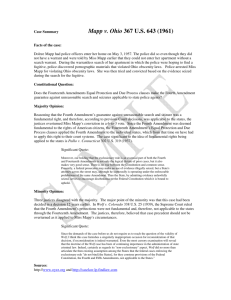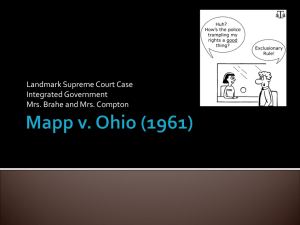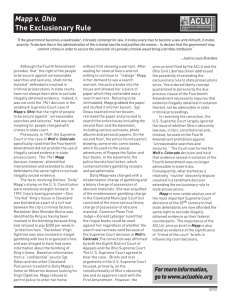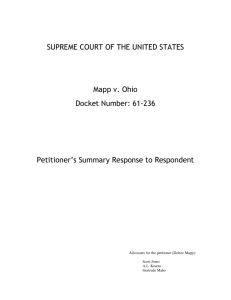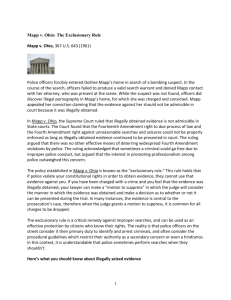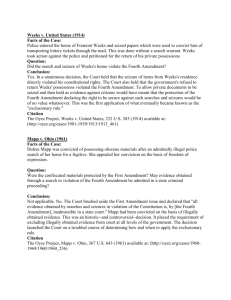HistoryProject
advertisement
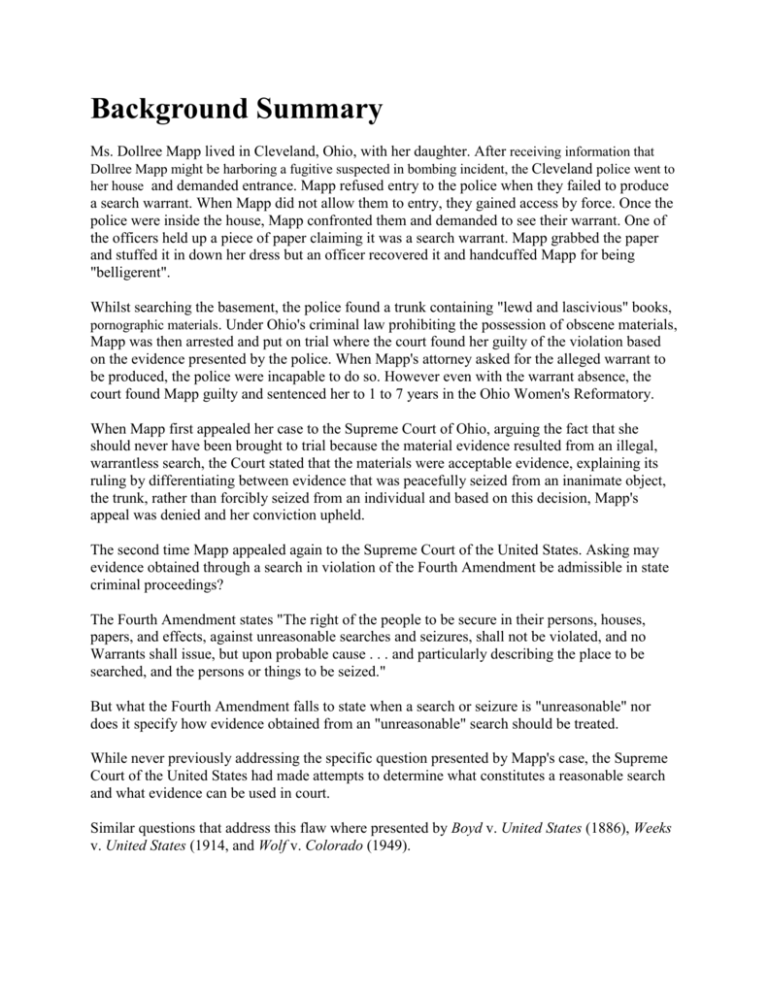
Background Summary Ms. Dollree Mapp lived in Cleveland, Ohio, with her daughter. After receiving information that Dollree Mapp might be harboring a fugitive suspected in bombing incident, the Cleveland police went to her house and demanded entrance. Mapp refused entry to the police when they failed to produce a search warrant. When Mapp did not allow them to entry, they gained access by force. Once the police were inside the house, Mapp confronted them and demanded to see their warrant. One of the officers held up a piece of paper claiming it was a search warrant. Mapp grabbed the paper and stuffed it in down her dress but an officer recovered it and handcuffed Mapp for being "belligerent". Whilst searching the basement, the police found a trunk containing "lewd and lascivious" books, pornographic materials. Under Ohio's criminal law prohibiting the possession of obscene materials, Mapp was then arrested and put on trial where the court found her guilty of the violation based on the evidence presented by the police. When Mapp's attorney asked for the alleged warrant to be produced, the police were incapable to do so. However even with the warrant absence, the court found Mapp guilty and sentenced her to 1 to 7 years in the Ohio Women's Reformatory. When Mapp first appealed her case to the Supreme Court of Ohio, arguing the fact that she should never have been brought to trial because the material evidence resulted from an illegal, warrantless search, the Court stated that the materials were acceptable evidence, explaining its ruling by differentiating between evidence that was peacefully seized from an inanimate object, the trunk, rather than forcibly seized from an individual and based on this decision, Mapp's appeal was denied and her conviction upheld. The second time Mapp appealed again to the Supreme Court of the United States. Asking may evidence obtained through a search in violation of the Fourth Amendment be admissible in state criminal proceedings? The Fourth Amendment states "The right of the people to be secure in their persons, houses, papers, and effects, against unreasonable searches and seizures, shall not be violated, and no Warrants shall issue, but upon probable cause . . . and particularly describing the place to be searched, and the persons or things to be seized." But what the Fourth Amendment falls to state when a search or seizure is "unreasonable" nor does it specify how evidence obtained from an "unreasonable" search should be treated. While never previously addressing the specific question presented by Mapp's case, the Supreme Court of the United States had made attempts to determine what constitutes a reasonable search and what evidence can be used in court. Similar questions that address this flaw where presented by Boyd v. United States (1886), Weeks v. United States (1914, and Wolf v. Colorado (1949). It first wrestled with these issues in Boyd v. United States (1886) when the Court declared that "any forcible and compulsory extortion of a man's own . . . private papers to be used as evidence to convict him of a crime . . . is within the condemnation of . . . [the Fourth Amendment]. Later, in Weeks v. United States (1914), the Court ruled that the Fourth Amendment "put the courts of the United States and federal officials . . . under limitations . . . and forever secure[d] the people, their persons, houses, papers and effects against all unreasonable searches and seizures. . . ." By including only United States and federal officials in its ruling, however, the Court still left open the question of whether evidence unlawfully seized could be used in a state criminal court proceeding. In Wolf v. Colorado (1949) the Court for the first time discussed the effect of the Fourth Amendment on the states. It concluded that the Due Process Clause of the Fourteenth Amendment incorporated, or made applicable to the states, the Fourth Amendment to the Constitution. However, the ruling in Wolf also made clear that "in a prosecution in a State court for a State crime the Fourteenth Amendment does not forbid the admission of evidence obtained by an unreasonable search and seizure." In other words, the exclusionary rule did not apply to the states. Some states, including Ohio, felt that they should be able to make their own determination regarding the admissibility of illegally obtained evidence. Nevertheless, in 1960 the Supreme Court of the United States agreed to hear Mapp's case and reconsider the decision it had reached in Wolf by determining whether the U.S. Constitution prohibited state officials from using evidence obtained in violation of the Fourth Amendment. The decision in Mapp v. Ohio was handed down in 1961. Mapp vs Ohio(1961) Upon searching her home Dolree Mapp was convicted of possessing obscene materials after an admittedly illegal police search of her home for a fugitive. The Fourth Amendment states "The right of the people to be secure . . . against unreasonable searches and seizures shall not be violated . . . " Point one: In appealing to the supreme court, as is her right giving by ----- that allows her to go to a higher court if court proceedings were not handled well. Were the confiscated materials protected by the First Amendment? (May evidence obtained through a search in violation of the Fourth Amendment be admitted in a state criminal proceeding?) The Warren Court left an unprecedented legacy of judicial activism in the area of civil rights law as well as in the area of civil liberties—specifically, the rights of the accused as addressed in Amendments 4 through 8. In the period from 1961 to 1969, the Warren Court examined almost every aspect of the criminal justice system in the United States, using the 14th Amendment to extend constitutional protections to all courts in every State. This process became known as the “nationalization” of the Bill of Rights. During those years, cases concerning the right to legal counsel, confessions, searches, and the treatment of juvenile criminals all appeared on the Court's docket. The Warren Court's revolution in the criminal justice system began with the case of Mapp v. Ohio, the first of several significant cases in which it re-evaluated the role of the 14th Amendment as it applied to State judicial systems. Constitutional Issues The question before the Court involved 4th Amendment protection against “unreasonable searches and seizures” and the “nationalization” of the Bill of Rights under the 14th Amendment. Was the search of Mapp's home legal and the evidence admissible under State law and criminal procedure? If the State criminal procedure code did not exclude the evidence as having been illegally gained, did Ohio law fail to provide Mapp her 4th Amendment protection against “unreasonable searches and seizures”? Weeks v. United States, 1914, established the exclusionary rule barring the admission of illegally obtained evidence in federal courts. Should that rule be extended, making evidence gained by an illegal search inadmissible in State courts as well? Mapp Appealed to the ohio supreme court under the bases that any incriminating evidence found during the search should be thrown out of court and her conviction overturned. If the 4th Amendment did not limit the prerogatives of police on the local and State level, local law enforcement would have a mandate to search wherever, whenever, and whomever they pleased. The exclusionary rule that applied in federal courts should also be applied to State court proceedings. The state of Ohio argued that even in the case of incriminating evidence found during an illegal search and seizure, the State is justifiable in using such evidence because the 14th Amendment does not forbid the admission of evidence obtained by an unreasonable search and seizure. The 14th Amendment does not guarantee the 4th Amendment protections in the State courts. How the Case Moved through the Court System The Fourth Amendment provides that all citizens shall be protected against unreasonable search and seizures. The rationale behind the exclusionary rule is the protection of the Fourth Amendment’s right to privacy, which is owed to every citizen. Want to make a movie go to: http://www.xtranormal.com/makemovies/ what were the facts of the case? Why was this case brought to the supreme court? What freedom or right was at issue? How was the issue? How and why did the Supreme Court decide the case as it did? How did this case change how we understand or interpret the Constitution? Were there dissenting opinions? Why did they dissent? WORDS IN BLUE FONT ARE NOT WRITTEN BY US, THEY ARE TAKEN DIRECTLY FROM THE SOURCE AND WILL BE CONSIDERED PLAGERIZED IF NOT RE-WORDED FOR OUR PROJECT.

